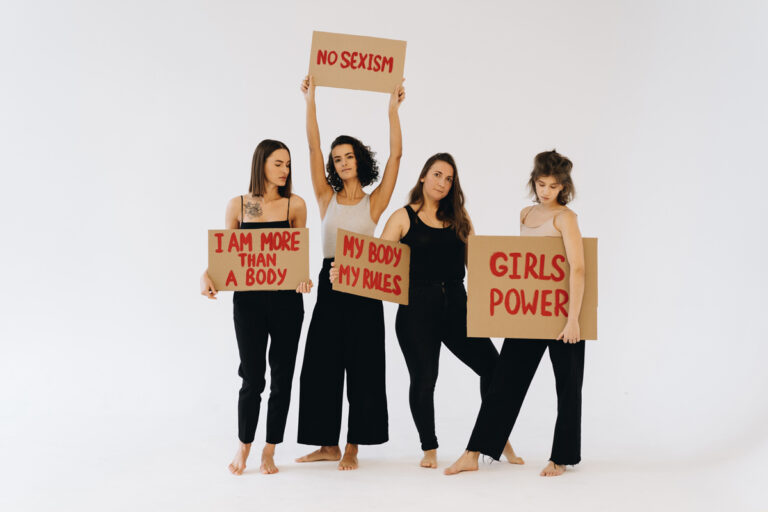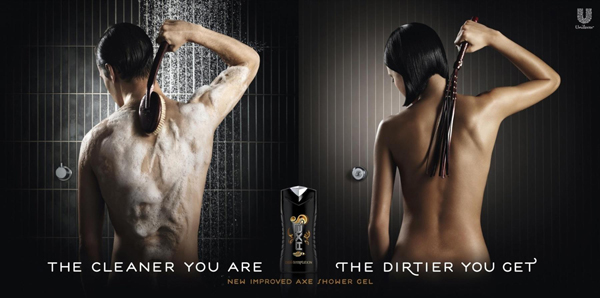Brands are using ‘sneakily sexist’ language to trick women. Here’s how it can be fixed

Remember Sprite’s ‘Brutally Refreshing’ ad campaign from 2016, which brutally offended women with lines like “She’s seen more ceilings than Michelangelo” and “You’re not popular, you’re easy”? What about last year, when Peloton dropped a holiday commercial portraying a Black Mirror version of the happy housewife? Surely you would recall the UK government’s ‘Stay at home’ COVID-19 advert from three months ago, which illustrated all household chores being done by women with a lone man lounging on the couch.
Let’s face it, advertising is inherently sexist despite all of the other criticisms it has gathered over the years. And as we now shift into an era with multiple waves of representation and empowerment of various communities, it seems that brands have found a new way to ride them into a profitable sunset.
Femvertising and the illusion of progressive ideals
Before we break down 2021’s sneaky advertising playbook, let’s address some age-old concepts used by brands to foster an illusion of progressive ideals among consumers. ‘Femvertising’ seems to be a good place to start in this regard. Synonymous with ‘hashtag feminism’, femvertising is a marketing tool leveraged by brands to literally sell empowerment to women.
The marketing trend essentially revolves around ‘slacktivism’—surface activism similar to changing the overlay on your Facebook profile picture to support a cause. Think about Dove’s ‘Real Beauty’ campaign and CoverGirl’s #GirlsCan. While both the ad campaigns seek to diversify the representation of women and girls in the media by challenging restrictive beauty standards and rhetorics, they failed to practice what they preach while shying away from the ‘feminist’ label.
“In order for femvertising to seem genuine rather than manipulative, the campaign must reflect a sustained effort on behalf of the brand to empower women and girls through philanthropic efforts and organisational partnerships,” noted a research paper by Alexandra Rae Hunt for Boston College. While Dove’s Real Beauty campaign drove 30 times more exposure than paid media spaces and boosted the brand’s worth from $2.5 billion to $4 billion in under a decade, let’s not forget how Dove’s parent company Unilever also owns Axe—the popular male grooming brand known as Lynx in the UK. Backed by a plethora of degrading and sexist ads, the parent company thereby seems to contradict the ideologies it preaches through its subsidiaries.
In the case of CoverGirl and #GirlsCan, the campaign was about “discovering and encouraging girls to take up challenges, breaking barriers and turning ‘can’t’ into ‘can’.” Fronted by Pink and Ellen DeGeneres, the minute-long advert almost makes a consumer forget how CoverGirl spent fifty-long years telling young women “your personality needs layers, your face doesn’t.”

Brandsplaining and the rise of ‘sneaky sexism’
While femvertising was a concept coined back in 2014 following Dove’s campaign, there has been a recent boom of ‘sneaky sexism’. “But how is this concept any different?” I hear you ask. Yes, both are a play on much-outdated ideals but ‘sneaky sexism’ is characterised by what its name suggests. It sneakily allows advertisers to slip in small doses of sexism into their marketing campaigns while remaining relevant and flying under the cancel culture radar.
“We are now seeing a phenomenon that we describe as ‘sneaky sexism’—where brands nod along to the codes of the new era but continue with the old practices in ways that are disguised,” wrote Philippa Roberts and Jane Cunningham, co-authors of the book Brandsplaining, in a column for The Telegraph. Describing sneaky sexism as “implicit rather than explicit,” the duo highlighted how the obvious ‘pink and blue marketing’ is slowly being replaced by a more ‘coded version’—say pastel, floral decorative for her and dark and structured for him.
“Listen to the (usually male) voiceover and hear how the same old critical and perfectionist narratives are now being told in the subtext,” they wrote, noting how brands use words such as “wellness” to describe weight loss and “ageless” to position the anti-ageing market. “Look out for brands that replace the old ‘you need to fix your body’ narrative with one that now says ‘you need to fix your behaviour’.”
Labelling this narrative as the ‘good girl’ phenomenon, Roberts and Cunningham analysed 120 UK and US brand adverts, their websites, packaging and social media in their book Brandsplaining. They also surveyed 14,000 women in 14 countries across four continents to understand their attitudes and beliefs about marketing and advertising. Co-authoring the book after 15 solid years of research, the duo unveiled some of the techniques advertisers use to make themselves seem ‘fempowerment friendly’ to their customers.
An insight from their study proved how marketing is still representing women as “vacant and dumb.” “When we asked women what characteristics define them most, they put ‘sense of humour’ and ‘intelligence’ as two of the top three, yet only in 3 percent of ads are women actually being funny and are shown doing something that requires brain power of any kind,” the duo added.
A majority of women surveyed also agreed that advertising—as it stands—is not only unrepresentative but damaging. Three-quarters worry about the harm models featured in advertisements could have on body ideals among its female audience. 63 per cent further believe advertising is partly to blame for eating disorders.
“While social media has been a force for good for a lot of women in a lot of ways, it has also provided brands with a channel where they can go unnoticed and continue to play out these old ideas of what women should be,” said Cunningham in an interview with Marketing Week. The co-author highlighted how young women consuming these channels could be polarised into these ideals—eventually leading them into anxiety, eating disorders and self harm.
All publicity is not good publicity
Yes, you read that right. Let’s take the case of Peloton’s holiday commercial that I mentioned earlier. The advert featured a picture-perfect wife vlogging her journey with the indoor biking equipment and thanking her husband for changing her life with the purchase. While the commercial was written off as ‘sexist’, ‘lacking in diversity’ and ‘promoting unhealthy marriage dynamics’, one noteworthy consequence is how it led to a massive drop in Peloton’s share price—$1 billion in a day to be exact.
Among all the criticisms were also a list of parodies and suggestions for alternate plot lines, enough and more to make us believe that the commercial was indeed a missed opportunity for the company. It wasn’t even good publicity for them in this case. It just went on to prove how diversity in advertisements correlates to gains in revenues while stereotypical ones can also have a financial impact.
In 2019, The Advertising Standards Authority (ASA) banned ‘harmful’ gender stereotyping in advertisements. The rules stated that ads “must not include gender stereotypes that are likely to cause harm, or serious or widespread offence.” Although the rule has now been bedded for further monitoring, the effectiveness of the rules had faced tremendous scrutiny back in 2019 and 2020.
After the first six months of its introduction, the UK’s ad watchdog received 516 complaints about 229 individual commercials. PrettyLittleThing and People Per Hour were among other brands whose advertisements were banned over the “serious objectification of women.”
Adding to the list of cons faced by stereotypical advertising is research by Kantar which proved how advertisements depicting people in progressive, forward-looking roles substantially outperforms those that consumers consider being less progressive. At Unilever, for example, Kantar found progressive advertising creating 37 per cent more branded impact along with a 28 per cent increase in purchase intent. The FMCG giant is also the chair of The Unstereotype Alliance—a platform convened by UN Women to eradicate harmful gender-based stereotypes in all media and advertising content.
The ideal way forward
So, how can brands put an end to this loop once and for all without sneaking around? It all starts with a better understanding of a brand’s female consumer base—their present goals and aspirations rather than outdated ideals ripped off a 1940s advertising playbook. It seems like an obvious place to start but it is an essential step in the direction to get the formula right.
Expanding on the insights Roberts and Cunningham gathered through their research, physical appearance is not what women want to be defined by. Their intellect and sense of humour plays an important role in representation. Appearance, in fact, doesn’t even make the top 10 on their list.
“There’s a need for brands to face the reality that the old idea of women’s aspirations and what they want out of life are redundant. They need to review that and build it into all their thinking and models,” Cunningham advised. The authors also listed a number of brands that are getting it right by playing on constructive prepositions rather than critical ones. The list included Frida Mom, Girlfriend Collective and Starling Bank.
“They are very good on the ‘deeds not words’ front,” Roberts said. “They run their businesses in the same way in which they present themselves and tend to pay a lot of attention to women in the supply chain and women as employees—making sure it all begins at home rather than it being a front-of-house thing.” The author also added how their models are based on “circular and sustainable principles rather than old school, linear growth at any cost.”
Another factor is the addition of relevant values as pillars and guiding principles. This not only helps a brand drive business decisions but also guides their marketing efforts in terms of finding like-minded collaborators and curating social media calendars. This can in turn help a brand foster an emotional connection with consumers and create a community around values rather than products.
All of the research, case studies and quotes mentioned above point to one thing: stereotypical advertising—be it sneaky or otherwise—is not going to help brands achieve success in an era that is set to reclaim the word ‘femvertising’ back from the companies who have capitalised on it. Not only should brands preach positive ideals in their 30-second television spots, they are also expected to support the cause beyond the confines of their marketing schemes. The ones who continue to reference age-old playbooks would either get milkshake-ducked on social media or turn into sitting ducks in the process.




